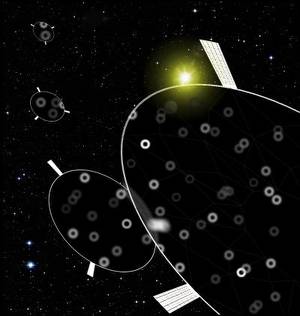RAIDs Against Global Warming
 This has "duh... why did we think of this before!" written all over it: a "redundant array of inexpensive disks" to cool the Earth.
This has "duh... why did we think of this before!" written all over it: a "redundant array of inexpensive disks" to cool the Earth.
Everyone with a bit of sense knows that the only way to combat global warming-induced climate disruption is through aggressive action to boost energy efficiency, shift to non-carbon energy production, and change our urban systems to increase lifestyle efficiency. Problem is, because of thermal inertia, we may already be too late to avoid catastrophic levels of planetary warming. We could well face a scenario in which our best efforts to cut carbon emissions end up still not happening fast enough to avoid a "tipping point" disaster (choose your apocalypse here: methane clathrates melting; complete collapse of ecosystems; heatwaves, wildfires and droughts killing millions; all of the above). That's why some of us argue that, on top of aggressive action (etc.), we need to look into plans for emergency cooling of the planet -- geoengineering, or as I like to call it, terraforming the Earth.
I've covered this idea before. What's new is the plan from Roger Angel at the University of Arizona. He's taken the tried-and-true solar shade concept -- a big umbrella between the Earth and the Sun blocking a small percentage of sunlight, enough to cool us down by a degree or two -- and given it the 21st century twist: Instead of a single solar shade thousands of miles in diameter, he proposes putting up (literally) trillions of tiny, 2 foot diameter microshades, acting as a distributed array of cooling. Such an approach would be cheaper than the single megashade, more robust (a nasty accident might damage hundreds or more, but have little overall impact on the swarm), and within our current technological capacity. No Moon base or asteroid capture required.
The lightweight flyers designed by Angel would be made of a transparent film pierced with small holes. Each flyer would be two feet in diameter, 1/5000 of an inch thick and weigh about a gram, the same as a large butterfly. It would use "MEMS" technology mirrors as tiny sails that tilt to hold the flyers position in the orbiting constellation. The flyer's transparency and steering mechanism prevent it from being blown away by radiation pressure.
How do we get 'em up there? Not with a rocket -- too expensive for that many (even at a gram apiece, the whole cloud would still weigh a total of 20 million tons). Angel proposes using 20 electromagnetic launchers (railguns, essentially), launching a stack of flyers every five minutes for ten years. Okay, that part sounds a bit sketchy, but make it 200 railguns and once an hour for ten years... or every five minutes for one year. And while the energy for launching this massive cloud of microshades would best come from renewable sources, Angel calculates that even the worst-case (coal power) scenario is that the disks would mitigate the effects of a thousand tons of carbon for every ton of carbon produced in powering the launchers.
It wouldn't be cheap -- amortized over its lifetime of about 50 years, the system would cost about $100 billion per year... or roughly the cost of the Iraq war. But considering the planetary devastation that would result from a climate tipping point (remember, melting methane clathrates look to be responsible for the worst mass extinction in Earth's history, even bigger than the asteroid that killed the dinosaurs), it's a bargain.





